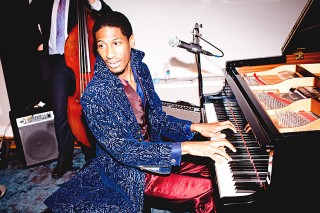Column Name
Title
Subhead

Since graduating from Juilliard in 2011, jazz pianist Jonathan Batiste has been keeping himself very busy.
(Photo by Christine Chambers)The National Jazz Museum in Harlem currently inhabits a space the size of a modest insurance office on the fourth floor of a non-descript building on East 126th Street, but when Jonathan Batiste (B.M. ’08, M.M. ’11, jazz studies) shows up one Wednesday each month for his Jazz Is Now series, the place seems as formidable as the history it is its mission to advance. The rising-star pianist has been an artistic director of the N.J.M.H. for four years now, a job he acquired by making an impression on former Juilliard instructor and saxophonist Loren Schoenberg, the museum’s cofounder. The monthly slot is part concert, part seminar. With help from his quintet, the Stay Human Band, Batiste explains the inner workings of jazz in simple, soulful language and then demonstrates the finer points, underlining the differences between verses and choruses, varying song structures, and jazz icons like Ahmad Jamal and Bill Evans. The capacity crowd gets as involved in the process as it is mesmerized by it.
Body
Of course, the museum is just one facet of a career that seems to be blossoming in several auspicious directions. It’s possible to hear Batiste fronting the Stay Human Band internationally as well as in the subway (brandishing a small air-keyboard called a “melodica,” or as he calls it, a “harmoni-board”), and he can now be seen on television, playing a transplanted musician not unlike himself in Treme, the hit HBO series about his hometown, New Orleans. Its third season begins on September 23. The TV work has had other consequences; Batiste recently wrapped Spike Lee’s film Red Hook Summer. With a surname that is synonymous with music in the Crescent City—among his famous musical relatives was Lionel Batiste, who had cameos in Treme (and appears in the poster) and who died in July—Jonathan Batiste is positioned to take that name around the world. Recently freelance writer K. Leander Williams sat down with him between gigs.
Let’s talk about the character you play in the new “Spike Lee joint.”
His name is T. K. Hazelton. He’s a musician, but he also happens to be the only taxi driver in the Red Hook housing projects in Brooklyn. My cab service serves the characters in the film, and we talk a lot about what’s happening in the community and stuff while driving around. In particular, I’m the main character’s confidante.
Are there any specific things you did to prepare for being a New York cab driver?
Well, I actually had to learn to drive. I knew how to do it, but I never drove in New Orleans, so I didn’t have a license. Actually, maybe I shouldn’t say this, but we shot the whole film without me having one. That’s illegal, I know.
Were you ever on sound stages?
No, always in the street. To tell you the truth, though, I felt more pressure from the cameras. The camera on the front seat of the car is right in your face. There was one on the back seat, too.
That’s a little different than the work on Treme.
Absolutely, though both characters are jazz musicians. It’s funny, though, when preparing for Red Hook Summer, I talked to many cab drivers, and what I found is that each one tries to have kind of a signature, a specific way they dress or something. I thought of that like how we try to have our own sound in jazz.
How did Treme come about?
Well, I was just trying to figure out a way to get my music featured on the show, and the producers asked me to read and screen-test for it. I was expecting maybe just a cameo or something, but then they asked me to do this recurring role. The lead character, Antoine Batiste [played by Group 14 alum Wendell Pierce], is based on one of my [extended] family members. In the show, I’m one of the musicians that another lead character plays with when he comes to New York. That’s another funny thing, because when I got the role I got really excited because I thought I’d be going home to New Orleans. I did some shooting there eventually, but my first scenes were shot in New York at Dizzy’s Club Coca-Cola.
At Juilliard, did you do any acting?
No, but quite a few actors were my buddies. I hung tight with a lot of them.
What have you learned from Spike Lee?
Diligence and focus. He knows how to see things through. It’s like he sees things and files them and comes back to them. I first came on his radar because the Stay Human Band plays the Harlem Little League opening ceremony every year; his son is in the league. I think he’d probably seen me play with Wynton Marsalis, too. All this was over about a four-year period, but he finally made the call. I had to get ready.




